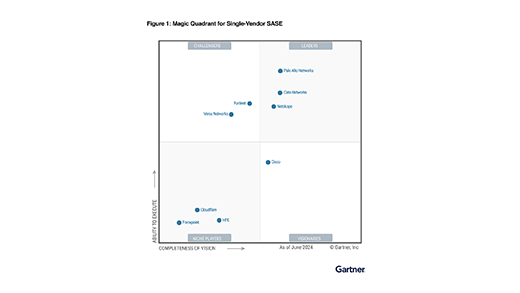2023 war das Jahr der generativen KI. Alles begann mit dem Hype um OpenAI und ihr Flaggschiffprodukt ChatGPT. Obwohl es nicht in die Top 20 der beliebtesten Apps des Jahres 2023 vordrang, konnte ChatGPT mehr Nutzer hinzugewinnen als jede andere App, wobei seine Popularität bis zum Jahresende von 0 % auf fast 7 % aller Unternehmensnutzer anstieg. Als ChatGPT immer beliebter wurde, begannen andere Unternehmen mit der Entwicklung konkurrierender Chatbots und noch mehr Unternehmen begannen mit der Entwicklung von Nischenprodukten, um die Leistungsfähigkeit dieser großen Sprachmodelle (LLMs) zu nutzen. Die Idee eines KI-gestützten Assistenten, der bei Aufgaben wie Schreiben, Programmieren und sogar Sicherheitsoperationen hilft, wurde populär. Gleichzeitig wurden auch Apps zur Generierung von Bildern, Videos und Audio veröffentlicht.
Die Community für Cybersicherheit in Unternehmen hat das getan, was sie normalerweise tut, wenn eine neue Technologie mit so viel Hype auf den Markt kommt: Sie hat schnell festgestellt, ob diese Apps einem legitimen Geschäftszweck dienen, und – wenn dies der Fall ist – herausgefunden, wie ihre Verwendung sicher ermöglicht werden kann. Für viele Organisationen bedeutete dies, auf die Bremse zu treten und die Apps zu blockieren, bis sie eine ordnungsgemäße Sicherheitsüberprüfung durchlaufen hatten. Im Allgemeinen bedeutete dies, dass diese generativen KI-Apps im Unternehmensbereich langsamer an Popularität gewannen als auf dem Verbrauchermarkt.
Aber ihre Popularität wuchs. Die folgende Grafik zeigt einen Anstieg der Popularität von KI-Apps, der einer Sigmoidkurve ähnelt. Vor einem Jahr griffen knapp über 2 % aller Unternehmensbenutzer auf mindestens eine KI-App pro Monat zu, heute sind es über 10 %. Der Großteil dieses Wachstums fand in der ersten Hälfte des Jahres 2023 statt und kühlte sich gegen Jahresende ab.

Eine Darstellung des Wachstums der drei wichtigsten Apps für generative KI bietet einen besseren Einblick in die Form des obigen Diagramms zur allgemeinen Beliebtheit. ChatGPT war mit großem Abstand die beliebteste App, auf dem zweiten Platz landete der Schreibassistent Grammarly, gefolgt vom Google Bard-Chatbot auf dem dritten Platz. Die folgende Grafik bietet eine detaillierte Aufschlüsselung des Wachstums dieser drei Apps. ChatGPT war im ersten Halbjahr der Haupttreiber des sigmoidalen Wachstumsmusters und stieg sehr schnell von fast 0 % auf 7 % der Unternehmensbenutzerpopulation. Google Bard hatte später im Jahr, als es allgemein verfügbar wurde, eine ähnliche Wachstumsform, seine Akzeptanz war jedoch im Vergleich zu ChatGPT eher gering. Aufgrund seiner bereits bestehenden Benutzerbasis startete Grammarly das Jahr als beliebteste KI-App, und obwohl es kein so starkes Wachstum wie ChatGPT verzeichnete, ist seine Popularität weiterhin steigend. Netskope Threat Labs prognostiziert, dass Grammarly im nächsten Jahr weiterhin an Popularität gewinnen und die Lücke zwischen sich und ChatGPT schließen wird, aber immer noch hinter dem Allzweck-Chatbot zurückbleiben wird.

Die meisten Benutzer interagieren nur ein paar Mal im Monat mit Apps für generative KI. Im Laufe des letzten Jahres stieg die Anzahl der durchschnittlichen Benutzeraktivitäten von 5 auf 14 Aktivitäten pro Monat, wobei es sich bei einer Aktivität meist um eine an einen Chatbot gesendete Eingabeaufforderung handelt. Im obersten Quartil der KI-App-Nutzer war im Jahresverlauf ein deutlicherer Anstieg von 15 auf 85 Aktivitäten zu verzeichnen. Dies deutet darauf hin, dass ein Viertel aller KI-Anwender Poweruser sind, die ihre Nutzung generativer KI-Apps immer schneller steigern. Netskope Threat Labs geht davon aus, dass sich beide Trends bis 2024 fortsetzen werden: Die Gesamtzahl der Benutzer, die in Unternehmen auf KI-Apps zugreifen, wird weiterhin nur geringfügig ansteigen, während die Aktivität von Power-Usern erheblich zunehmen wird, da die Population der Super-User neue Wege findet, um zusätzlichen Nutzen aus diesen Technologien zu ziehen.

Ein genauerer Blick auf die Top 10 der generativen KI-Apps zum Ende des Jahres 2023 zeigt drei bemerkenswerte Trends, von denen wir erwarten, dass sie sich auch im Jahr 2024 fortsetzen werden.

Chatbots sind unangefochten
ChatGPT, der erste generative KI-Chatbot, der an Popularität gewann, liegt Ende des Jahres immer noch an der Spitze: 6,7 % der Unternehmensbenutzer interagieren mindestens einmal pro Monat mit dem Chatbot. Google Bard, die ChatGPT-Alternative von Google, ist der zweitbeliebteste Chatbot, hat aber nur etwas mehr als ein Zehntel der Nutzerbasis. ChatGPT und Google Bard sind universell einsetzbar und können zur Unterstützung von Geschäftsfunktionen, beispielsweise als Hilfe bei Schreib- und Programmieraufgaben oder beim Abrufen von Informationen, oder zur Unterhaltung eingesetzt werden. Ihre Vielseitigkeit ist einer der Hauptgründe für ihre Beliebtheit. Andere, eher nischenorientierte Chatbots zur Kundeneinbindung – ChatBase und Blip – schafften es ebenfalls in die Top Ten, hatten allerdings noch weniger Benutzer.
KI-Assistenten holen auf
Eine der bisher beliebtesten Anwendungen generativer KI-Technologie in Unternehmen ist der Einsatz als Schreibassistent. Grammarly, die zweitbeliebteste App für generative KI, wird von 3,1 % der Unternehmensbenutzer verwendet. Die Alternativen QuillBot und Wordtune schaffen es ebenfalls in die Top Ten. Tabnine ist ein Programmierassistent, der Programmierern hilft, Code effizienter zu schreiben. Netskope Threat Labs geht davon aus, dass die Popularität von KI-Assistenten, insbesondere Schreib- und Programmierassistenten, im Jahr 2024 weiter steigen wird. Ihre Integration in häufig verwendete Tool-Sets zum Schreiben und Programmieren und die Tatsache, dass sie speziell für diese Aufgaben entwickelt und abgestimmt sind, werden ihre wachsende Popularität vorantreiben. Die Tatsache, dass sie nicht zu Unterhaltungszwecken eingesetzt werden können, wird wahrscheinlich auch Hindernisse für ihre Einführung in Unternehmen beseitigen, wohingegen andere Apps, wie etwa allgemeine Chatbots, darunter leiden könnten.
KI-Kunstgeneratoren halten Einzug in Unternehmen
KI-Kunstgeneratoren, insbesondere solche, die Bilder generieren können, haben es auf die Plätze 9 und 10 der beliebtesten generativen KI-Apps im Unternehmen geschafft. Wie Chatbots sind KI-Kunstgeneratoren Allzweckwerkzeuge, die zur Unterhaltung oder zur Unterstützung von Geschäftsfunktionen eingesetzt werden können, was zu ihrer Beliebtheit in Unternehmen beiträgt. Aufgrund ihrer Verwendung im Unterhaltungsbereich und insbesondere ihrer Fähigkeit, nicht arbeitsplatztaugliche Inhalte zu generieren, werden sie in Unternehmensumgebungen auf absehbare Zeit wahrscheinlich weiter unten auf der Beliebtheitsskala stehen.




 Zurück
Zurück 

















